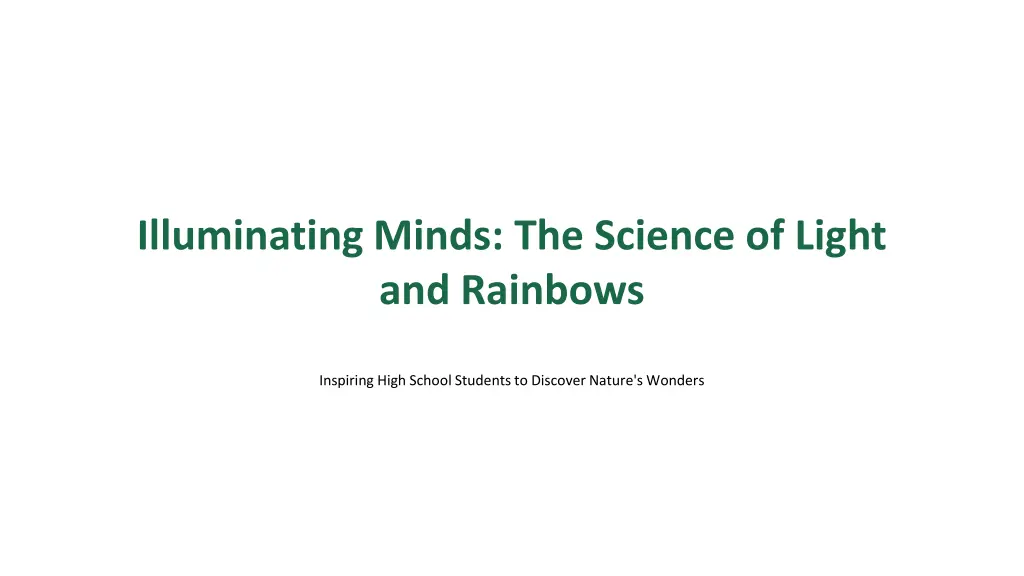
Exploring Light and Rainbows for High School Students
Dive into the fascinating world of light and rainbows with "Illuminating Minds: The Science of Light and Rainbows." Discover the essence of light energy, the journey of light from various sources, the magic of prisms and color spectrums, the science behind rainbows, and how to inspire the next generation of scientists through engaging hands-on learning experiences. Join us in illuminating young minds and nurturing a passion for scientific exploration!
Download Presentation

Please find below an Image/Link to download the presentation.
The content on the website is provided AS IS for your information and personal use only. It may not be sold, licensed, or shared on other websites without obtaining consent from the author. If you encounter any issues during the download, it is possible that the publisher has removed the file from their server.
You are allowed to download the files provided on this website for personal or commercial use, subject to the condition that they are used lawfully. All files are the property of their respective owners.
The content on the website is provided AS IS for your information and personal use only. It may not be sold, licensed, or shared on other websites without obtaining consent from the author.
E N D
Presentation Transcript
Illuminating Minds: The Science of Light and Rainbows Inspiring High School Students to Discover Nature's Wonders
01 The Nature of Light Table of Contents 02 The Journey of Light 03 Prism and Color Spectrum 04 The Science of Rainbows 05 Inspiring Future Scientists
1 The Nature of Light Light is a form of energy that travels in waves, crucial for our perception of the world. It allows us to see colors, shapes, and everything around us. Understanding light is key to grasping many scientific concepts. Light travels at an incredible speed, approximately 299,792 kilometers per second. Its interaction with different materials leads to fascinating phenomena we observe daily. Encouraging students to explore the physics of light can spark their passion for science.
2 The Journey of Light Light originates from multiple sources, includingthe sun, artificial lights, and fire. The process of light generation involves energytransformation, a fundamental concept in physics. Exploring how different light sources affect the environmentcan lead to engaging discussions. Highlighting practical applications, such as photographyand optics, makes learning relevant. Students can be inspired to innovate by understanding the journey light takes.
3 Prism and Color Spectrum A prism is a powerful tool that separates white light into a spectrum of colors: red, orange, yellow, green, blue, indigo, and violet. This interaction is due to refraction, where light bends at differentangles depending on its wavelength. Understanding prisms can lead students to explore various creative fields like art and design. The beauty of color can also inspire appreciation for nature and the arts. Encouraging experiments with prisms can ignite curiosity about light behavior.
4 The Science of Rainbows Rainbows form when sunlight refracts, reflects, and disperses throughwater droplets in the atmosphere. Each color in the rainbow has a unique wavelength, creating the stunning arc we admire. Learning about rainbows offers insights into weather patterns and the nature of light. Rainbows symbolize hope and beauty, fostering emotional connections in students. Inspiring students to observe rainbows can deepen their appreciation for naturalphenomena.
5 Inspiring Future Scientists By integrating lessons on light and rainbows across disciplines, we can enhance studentengagement. Hands-on experiments and outdoor explorations can solidify understanding and spark creativity. Encouraging questions and curiosity nurtures a scientific mindset and fosters critical thinking. Connecting light science to real-world applications can guide students to future careers. Let us inspire the next generation to explore, discover, and illuminate their paths.
